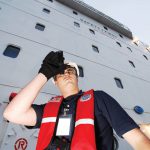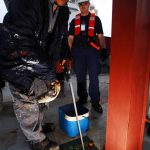Debra DiCianna, Senior Environmental Solutions Engineer with classification society ABS, talks about the differences between IMO and USCG ballast water management rules, the readiness of technology, and the time lag in adoption
What is the current regulation status of ballast water management (BWM) concerning US waters?
Debra DiCianna: The compliance[ds_preview] dates for ballast water discharge standards have been established and we are now in a timeframe where shipowners need to be either installing a BWM system or requesting extension letters from the US Coast Guard (USCG). Extension letters need to include sufficient detail for a useful extension period and the initial extensions granted by the USCG are only for two years.
There are reports that the USCG and the Environmental Protection Agency (EPA) disagree in some aspects regarding the implementation of the new rules. Would you please comment on that?
DiCianna: My understanding is different. The USCG and EPA do not disagree. Indeed, their joint memo illustrates their co-operation. USCG ballast water regulations and EPA’s Vessel General Permit (VGP) have different legal requirements and the EPA needs to follow different legal requirements that are included in the Clean Water Act and NPDES permit program. The VGP cannot include exemptions for a specific vessel for only one discharge. The EPA published a new enforcement policy that stated a »low enforcement priority« for vessels meeting specific criteria.
Will the IMO Ballast Water Management (BWM) Convention »interfere« with the USCG rules as soon as the IMO regulation is in place? How do they differ?
DiCianna: I don’t see that the BWM Convention interferes at all with the USCG ballast water rules. The BWM Convention and USCG ballast water rules include the same discharge standards and have the same overall goals of reducing the spread on invasive species. The USCG ballast water rule addresses some of the general »guidelines« for the BWM system with more detailed requirements, such as the Environmental Technology Verification (ETV) protocol. The USA chose to include more details – as many Port States may choose to do with the IMO BWM Convention. The most significant difference is the separate Type Approval process for the USCG. The USCG needed to address their requirements for the USCG Type Approval program – that deals with many other types of equipment.
The USA has not yet signed the Ballast Water Management Convention. When do you expect a ratification?
DiCianna: The USA may not ratify the IMO BWM Convention as it has its own, quite separate rules for ballast water management and will not want to sign up to a convention for which it would be bound to make modifications in future.
Did US shipowners react early enough to meat the new rules? Or is there a time lag?
DiCianna: Shipowners certainly did not react in a concerted way to the rules. Some have been proactive in adopting ballast water management practices, while others have taken a wait-and-see approach. That inevitably led to a situation where feedback and comment to the US Coast Guard and EPA during the public comment phase was somewhat inconsistent. At ABS, we are increasing our interaction with the regulatory bodies to provide the most useful information and support possible to ensure future actions receive sufficient information to generate useful solutions.
How do you judge arguments from the shipping side that the technology hadn’t been ready in the last years? Suppliers see that totally different, of course.
DiCianna: Until positive testing results using the USCG ETV protocol are published, there will always be a tendency to view the technology as not being ready. Some reports of test failures of filters in particular have impacted perceptions but these are not irreconcilable problems. This is a new technology and there will be a period of trial and error as the industry adapts.
Equally, the system suppliers need to be positive and shipowners need to seek advice from their classification society to help them understand the pros and cons of the available BWM systems. Close co-operation between owners, manufacturers, regulators and class is imperative during this bedding in period.
Which types of treatment technologies like filters, UV, ozone, electrolysis, deoxygenation etc. have proved most efficient from your point of view?
DiCianna: Each type of ballast water management system has its benefits and drawbacks depending on a particular owner’s operations. The most efficient and useful BWM system is one that is easy to operate and can extract data for reporting and demonstration of compliance. Shipowners will tend towards using systems that are easy to operate – in the end, this is the most important feature.
What do you recommend customers to do depending on vessel type and investment costs?
DiCianna: In general, we recommend that shipowners and operators ask for assistance so that the issues and options available to them are clearly understood. ABS offers support to owners and managers to enable them to select the option best-suited for their particular operations to be in compliance with the IMO BWM Convention or Coast Guard requirements. Therefore, ABS has completed an update to its »Ballast Water Advisory« for publication early in 2014. This advisory has undergone significant revisions covering US and international requirements and available BWM systems. The new edition also includes worksheets which owners can use to plan system selection and develop their own BWM plan.
The »Guide to Ballast Water Treatment«, ABS’ own rules covering the installation of BWM systems, is also being revised for publication early in 2014.
What’s your prognosis regarding the number of BWM systems installed on board ships at the end of 2014 worldwide?
DiCianna: It’s hard to give concrete numbers. However, progress was being made – not just on newbuilds but on existing ships, too. Unfortunately, the ratification process of the BWM Convention slowed down and the uncertainty over USCG Type Approval occurred, which also acted to slow down the pace of installations. In December 2013, I made a presentation at BWMTech in London regarding the status of BWM systems installed. As of August 2013, approximately 203 ABS-classed vessels have such systems on board. Other classification societies have published similar numbers and most of the installations to date have been made on newbuildings.
Nikos Späth





















